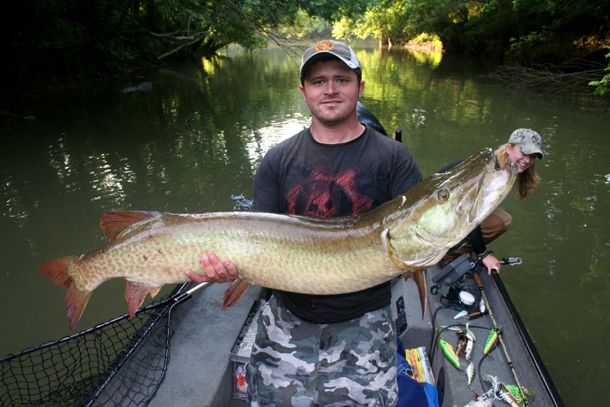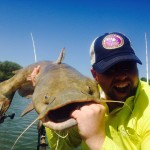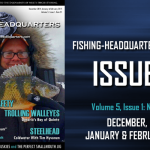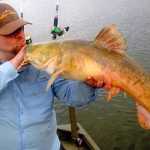By Cory Allen
Since the beginnings of charted exploration, cartographers were given accounts of fierce creatures prowling the waters just beyond the edges of the map. To the Greeks, it was Scylla and Charybdis, the guardians of the Bosporus. To the Norse, the doom of countless ships that left calm shores never to return had two names… Jormungand and Kraken. As generations passed, technology advanced, and the human race grew to greater understanding, the borders of the map eventually all met to create the modern globe, and many of the former monsters fell into myth. Yet, even today, in the age of satellite navigation on cell phones, and the luxury of pizza delivery without even utilizing vocal cords, there are still waters in regions uncharted by the modern musky hunter. Despite instantaneous multimedia coverage of the hottest action in musky angling, there remains a hidden chronicle and untapped population of musky at the bottom of the known musky range. These waters are still being charted in the musky world, but one thing’s for sure… there really still are spots on the map marked “Here be dragons…”

Still in the palm of winter’s grip, a resounding majority of musky hunters are stuck in front of the television or an 8″ hole in the ice pursuing the prey of their quarry of choice. It is a pitiful site to see a knight who has long since slated a dragon. I have seen these poor souls on my visits to the North country during this time of year. Most aisles of musky tackle are no more comforting to an esox angler than a warm pie behind the glass of a bakery to an orphan. As they walk, heads hung, arms sullenly dropped to the side, I can’t help but hear the melancholy chord structure of Vince Guaraldi’s theme to “A Charlie Brown Christmas”.
I cant personally attest to the trials of the musky “off-season.” Growing up in southern Illinois fishing Kinkaid Lake then moving to middle Tennessee only to find several trophy musky fisheries, several maintained by sheer genetics alone, I cannot say that I have shared those winter woes, nor honestly can I fathom them. The waters I fish and guide are open throughout the year, with the branching arms of our systems bearing unique fruit for each season to those who are willing to work for them.
While we personally target musky down in middle Tennessee year around, from deep trolling in the fall to Summer night fishing in kayaks on the lazy rivers amidst the lush symphony of cricket song, perhaps the most intriguing aspect of our fisheries is the one water action they boast when most above the Mason-Dixon line are flocking to sport shows and relying on TiVo to tap the veins of their addiction.
The glorious Dixie offers more than its modesty alludes to in the way of esox arenas, many of which boast far more than novelty value, providing true potential at fish that would truly be the belles of any ball, from Nashville to Ottawa. Perhaps most amazing is how well kept these secrets have been, considering many of these musky waters have existed for decades, even eons, expressing beyond the circumstances of over harvest and lack of management the true range of the muskellunge.

Yes, muskellunge are originally native to many of the streams and rivers along the Cumberland plateau. Following the institution of the TVA, and the subsequent industrialization of the South, many of these native fisheries were altered beyond the point of repair, and in the 50’s, the muskellunge was listed as an endangered species in the Volunteer state. While much of the original genetic stock has been tainted and deteriorated through mandatory stocking from outside sources, there are still remnants of this strain, protected by the National Heritage Species act, that keep a stronghold in some of the more remote regions of the Obed Scenic River national conservancy. Surprisingly as well, muskellunge occasionally show up in creels as far south as Chattanooga, and the Chattanooga Aquarium once hosted a muskellunge, unaccounted for in stocking, that was captured in Nickajack Lake for an exhibit showcasing the typical species lineup for a southern TVA reservoir. Ironically, this isolated incident alludes to a much more common phenomenon than most realize. Musky cannot only exist and thrive in southern the waters they are native to or supplementally stocked, but they miraculously find themselves in New waters through the vast labyrinth of locks, dams, and tributaries in Tennessee and grow rapidly. I can personally attest to musky caught incidentally by myself and other anglers in Watts Bar reservoir, Center Hill, and Cordell Hull reservoir, all miles from stocked musky water and all separated by at least one hydroelectric dam from stocked or sustaining population waters.
Just this past fall, a 48″ musky was captured in Woods Reservoir near Tullahoma, Tennessee, a reservoir that discontinued its once ambitious over 20 years ago. Ironically, the Duck River, known as one of the most ecologically diverse and healthy habitats on the planet, flows into Woods…in the immortal words of Jeff Goldberg’s Professor Ian Malcolm ala Jurassic Park…”Life will find a way…”

Cory Allen, 27, of Cookeville, Tennessee is the founder and lead guide of Stone’s Throw Adventures. Allen’s team of guides fish the waters throughout Tennessee and Kentucky, guiding on a year-round basis, and offer their clients a wide variety of boat and wading trips for all species of gamefish. http://www.stonesthrowadventures.com/














